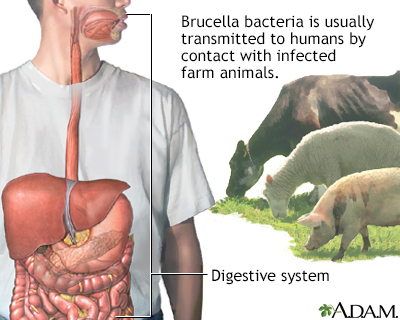Definition
Brucellosis is a bacterial infection that occurs from contact with animals carrying brucella bacteria.
Alternative Names
Cyprus fever; Undulant fever; Gibraltar fever; Malta fever; Mediterranean fever
Causes
Brucella can infect cattle, goats, camels, dogs, and pigs. The bacteria can spread to humans by:
- Coming in contact with infected meat or the placenta of infected animals
- Eating unpasteurized cheese
- Drinking unpasteurized milk
Brucellosis is rare in the United States. About 100 to 200 cases occur each year. Most cases are caused by the Brucella melitensis bacteria.
People working in jobs where they often come in contact with animals or meat are at higher risk. This includes slaughterhouse workers, farmers, and veterinarians.
Brucella is found in many countries worldwide including:
- Egypt
- Iraq
- Iran
- Jordan
- Saudi Arabia
- Chad
- Greece
- Mexico
Symptoms
Acute brucellosis may begin with mild flu-like symptoms, or symptoms such as:
- Abdominal pain
- Back pain
- Fever and chills
- Excessive sweating
- Fatigue
- Headache
- Joint and muscle pain
- Loss of appetite
- Swollen glands
- Weakness
- Weight loss
High fever spikes often occur every afternoon. The name undulant fever is often used to describe this disease because the fever rises and falls in waves.
The illness may be chronic and last for years.
Exams and Tests
The health care provider will examine you and ask about your symptoms. You'll also be asked if you've been in contact with animals or possibly eaten dairy products that were not pasteurized.
Tests that may be done include:
Treatment
Antibiotics are used to treat the infection and prevent it from coming back. These include:
- Doxycycline
- Streptomycin
- Gentamicin
- Rifampin
Often, you need to take the drugs for 6 weeks. If there are complications from brucellosis, you will likely need to take the drugs for a longer period.
Outlook (Prognosis)
Symptoms may come and go for years. Also, the illness can come back after a long period of not having symptoms.
Possible Complications
Health problems that may result from brucellosis include:
- Bone and joint sores (lesions)
- Encephalitis (swelling or inflammation of the brain)
- Infective endocarditis (inflammation of the inside lining of the heart chambers and heart valves)
- Meningitis (infection of the membranes covering the brain and spinal cord)
When to Contact a Medical Professional
Contact your provider for an appointment if:
- You develop symptoms of brucellosis
- Your symptoms get worse or do not improve with treatment
- You develop new symptoms
Prevention
Drinking and eating only pasteurized dairy products, such as milk and cheeses, is the most important way to reduce the risk for brucellosis. People who handle meat should wear protective eyewear and clothing and protect skin breaks from infection.
Detecting infected animals controls the infection at its source. Vaccination is available for cattle, but not humans.
References
Gotuzzo E, Ryan ET. Brucellosis. In: Ryan ET, Hill DR, Solomon T, Aronson NE, Endy TP, eds. Hunter's Tropical Medicine and Emerging Infectious Diseases. 10th ed. Philadelphia, PA: Elsevier; 2020:chap 75.
Gul HC, Erdem H. Brucellosis (Brucella species). In: Bennett JE, Dolin R, Blaser MJ, eds. Mandell, Douglas, and Bennett's Principles and Practice of Infectious Diseases. 9th ed. Philadelphia, PA: Elsevier; 2020:chap 226.


